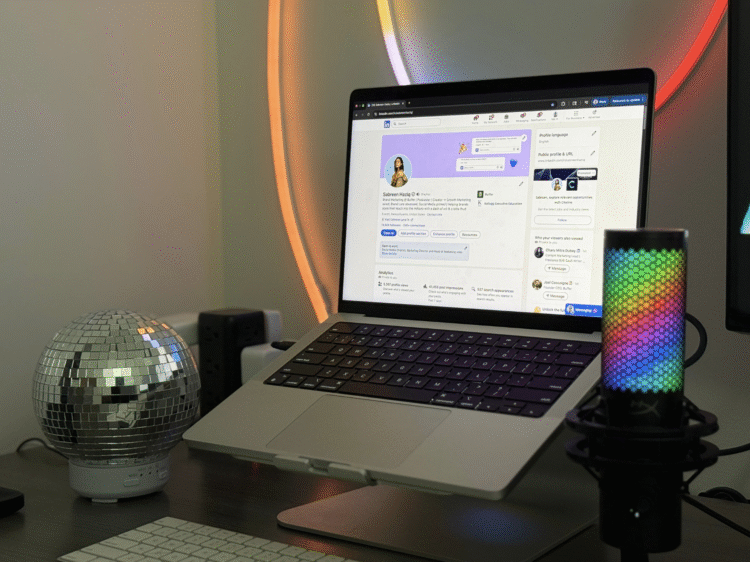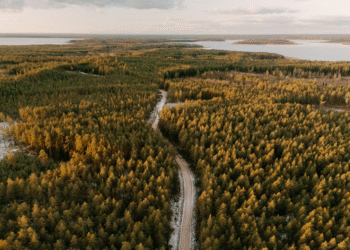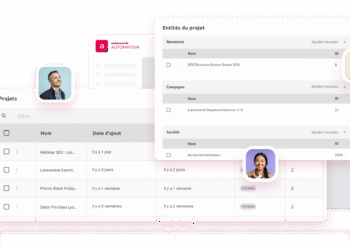For a long time, I treated LinkedIn like a platform to drop the occasional career update — not a platform to share original ideas, let alone daily posting. But over time, something shifted.
LinkedIn started to feel less corporate and more human. The rise of video content brought in a new wave of creators; and suddenly, the platform I’d mentally filed away as too buttoned-up started to feel like a space I could experiment in.
Right around the same time, Buffer launched Creator Camp; a 30-day community challenge to help creators stay consistent with daily prompts. That made the decision to invest in LinkedIn even easier. And then joining the Buffer team this year — where we’re on a mission to help creators and small businesses get off the ground and grow — gave me even more reason to lean in.
Since August 2024, I’ve posted on LinkedIn every single day without missing a beat. There were plenty of days where motivation was low and showing up felt like a stretch, but I did it anyway.
Here’s how I committed to LinkedIn consistency, even on the days I didn’t feel like showing up.
I started with a strong why
Before I ever committed to posting daily on LinkedIn, I knew I needed a reason that would hold up — not just on the good days, but on the boring, low-energy, what’s-the-point days, too.
For me, that reason was visibility. I wanted to build trust over time and stretch my brand beyond a role, a company, or a chapter of life.
I’ve spent my career growing brands from behind the scenes — telling their stories, scaling their presence, building the playbooks; and I’m proud of that work.
But a hard truth hit me during a layoff a few years ago:
I realized that while I had been pouring energy into growing other brands, I hadn’t been thinking about my own. There was no lasting signal of my contributions, no clear digital proof of what I stood for or how I thought. No audience of my own that associated me with the results I had helped create. That moment rewired something in me.
I realized I’d been playing small, and underinvesting in the credibility of my own name.
So I got clear. I wanted to build a personal brand on LinkedIn that did four things:
- Signaled my skills and point of view clearly
- Attracted like-minded marketers and collaborators
- Created a pipeline for paid side projects and consulting
- Let me run experiments on my own terms, without approval bottlenecks
In doing so, I wanted to design long-term leverage for future job opportunities. Once I had that clarity, showing up on LinkedIn became easier because I knew exactly why it mattered to stay consistent.
I defined my content pillars early on
One of the most helpful things I did early on was define my content pillars. Instead of figuring it out on the fly, I sat down, mapped them out, and made the investment upfront.
When your themes are clear, creating content doesn’t feel like grasping in the dark. You’re not relying on bursts of motivation or waiting around for inspiration to strike. You’ve built the rails, now you just keep the wheels turning.
For me, those lanes were:
- Personal branding — the craft I’ve built and something I now help others with
- Marketing lessons — a direct product of my day-to-day and the experiments I run
- Self-improvement — inspired by years of podcasting and personal development
- Corporate humor — a pressure release valve that invites a laugh when things get too heady
Each of these came naturally to me. I didn’t choose them because they were trendy. I chose them because I could speak to them from lived experience, and draw from them even on low-motivation days.
Once my pillars were in place, it became easier to build clusters of subtopics under each.
Over time, as I posted more content around my pillars and the topic clusters within each pillar, the themes created a heat map of sorts. Leaning into data, I could see which areas (topics) glowed brightest based on performance, and which ones I wanted to build on further. That data backed feedback loop — what resonated most with my audience — made it easier to stay creative and consistent, even when I didn’t feel like being “on.”
I built a system that fueled motivation, not burnout
A strategy without a system is like cola without the fizz. Who enjoys flat soda? Not me!
This was one of those upfront investments that paid off fast: I knew that if I could build a system that scaled, I’d free myself up to focus on the actual creating — not just busy work.
Unsurprisingly, Buffer was at the heart of it. Built by creators, for creators; it became my engine.
Most Fridays, I batch-created everything for the coming week and scheduled it out so it could run in the background while I focused on everything else. (Shoutout to Buffer’s four-day workweek for giving me the space to thrive in my role and as a creator!)
That, combined with the “Streaks” feature in Buffer, turned consistency into a game. Who likes their Streak at risk? Also not me!
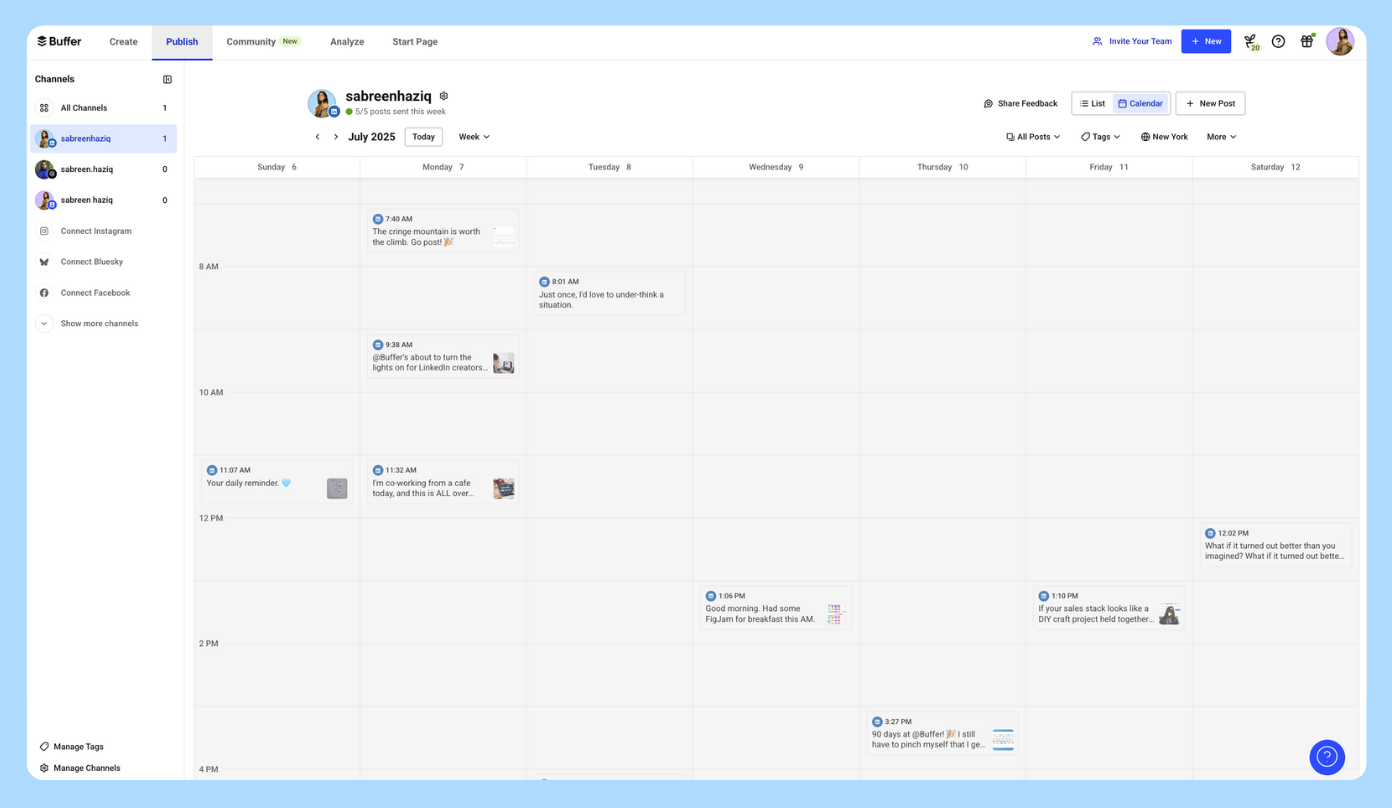
This system gave me enough breathing room to manually post over the weekend if I wanted to — and while I gave myself permission not to post on weekends, I always ended up doing it anyway. The pressure was off, but the habit was there.
I experimented with formats, but led with what felt sustainable
When I first committed to showing up on LinkedIn, I gave myself one rule: keep it simple. I focused exclusively on text-based posts. No graphics. No carousels. No video.
This wasn’t about playing small, but about protecting my creative energy. I wanted to go deep on one medium before diversifying across formats. For me, writing has always come naturally, and I knew that if I could build momentum there, everything else could layer on later.
That self-permission was foundational. It took the pressure off and gave me a lane I could stick to, especially on low-energy days.
At Buffer, we often talk about choosing consistency over perfection, and that’s exactly how I approached my content. I didn’t need to do it all from day one. I just needed to keep showing up in a way that felt sustainable.
Eventually, I found my rhythm. As my audience grew, so did the opportunities — sponsored content requests started rolling in, some static, some video. That’s when I dipped into video creation. I pushed my edges gently, played with new formats, and saw strong reception.
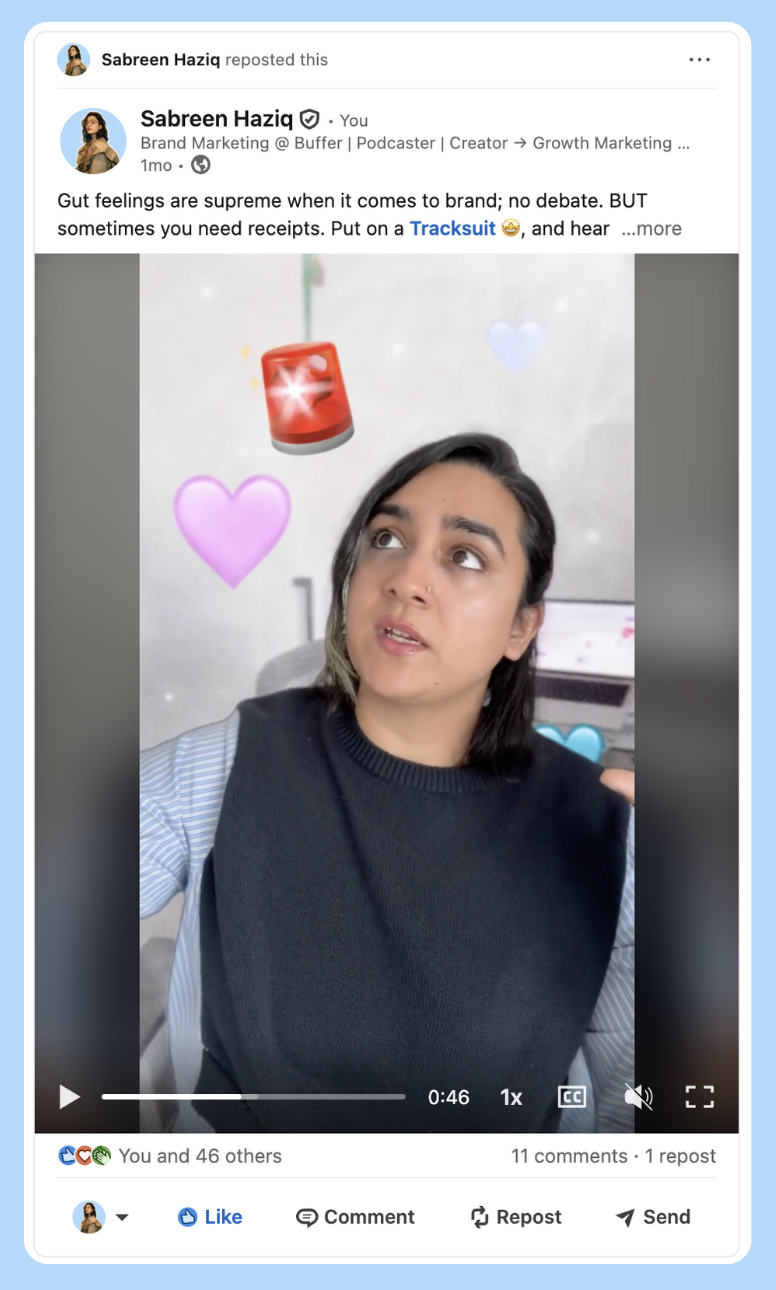
But I didn’t pivot to video entirely. I stayed honest about what was scalable for me. Video became a supporting act, not the whole show.
That balance — of evolving without pressure — is what helped me stay consistent, motivated, and creatively fulfilled.
I seasoned my content with AI
In a recent internal content creation workshop I held at Buffer, I explored the idea of content as pasta. You decide what kind of pasta you want to make — the shape, the texture, the base ingredients. That’s your raw idea. And then comes the seasoning: salt, pepper, olive oil. That’s where AI comes in.
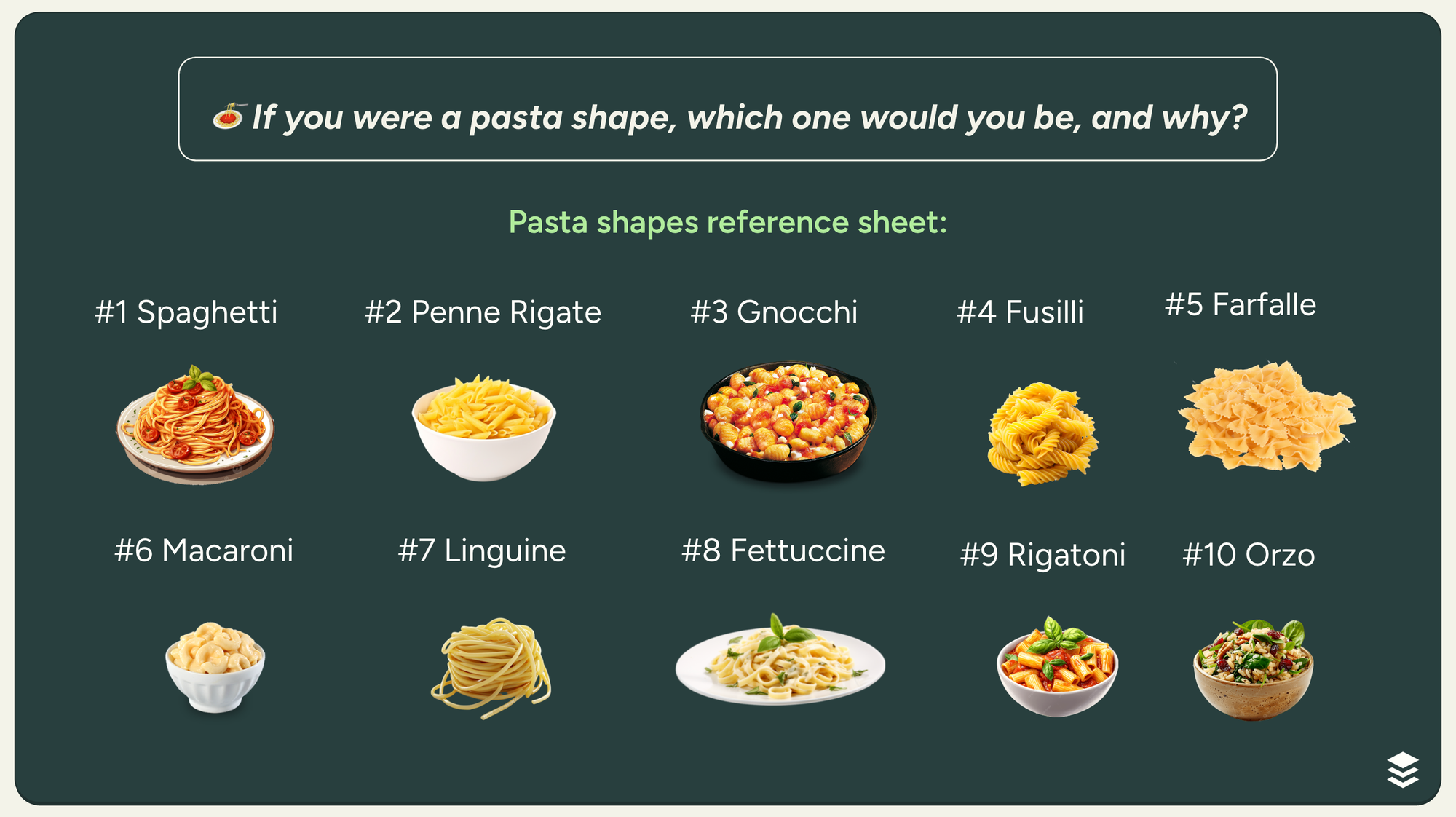
Once I had a clear sense of what I wanted to say on LinkedIn, I used AI as a flavor enhancer.
I leaned on it for structure, inspiration, and expansion. The more personality I fed into it, the more my tone of voice came through in return.
At first, it felt a bit clunky. The early drafts were stiff, sometimes overcooked. But over time, as I kept feeding AI more of me — my cadence, my word choices, my preferred formats — the content started to flow faster, and feel more like mine.
One of my favorite ways to use AI was for idea extension. If a post performed well, I’d ask:
What else could I write next that builds on this theme? Or:
What’s a natural sequel that would deepen this conversation?
That curiosity loop helped me create momentum at scale, without reinventing the wheel.
Using AI this way kept my content engine moving, and was especially helpful when my own energy dipped.
I added low-effort content to my strategy to make posting easier
When I initially mapped out my content pillars, I was intentional about balance, but I didn’t want every post to demand deep storytelling or high-stakes thought leadership. I needed space to play.
That’s why I added a lighter-touch pillar to the mix: corporate humor.
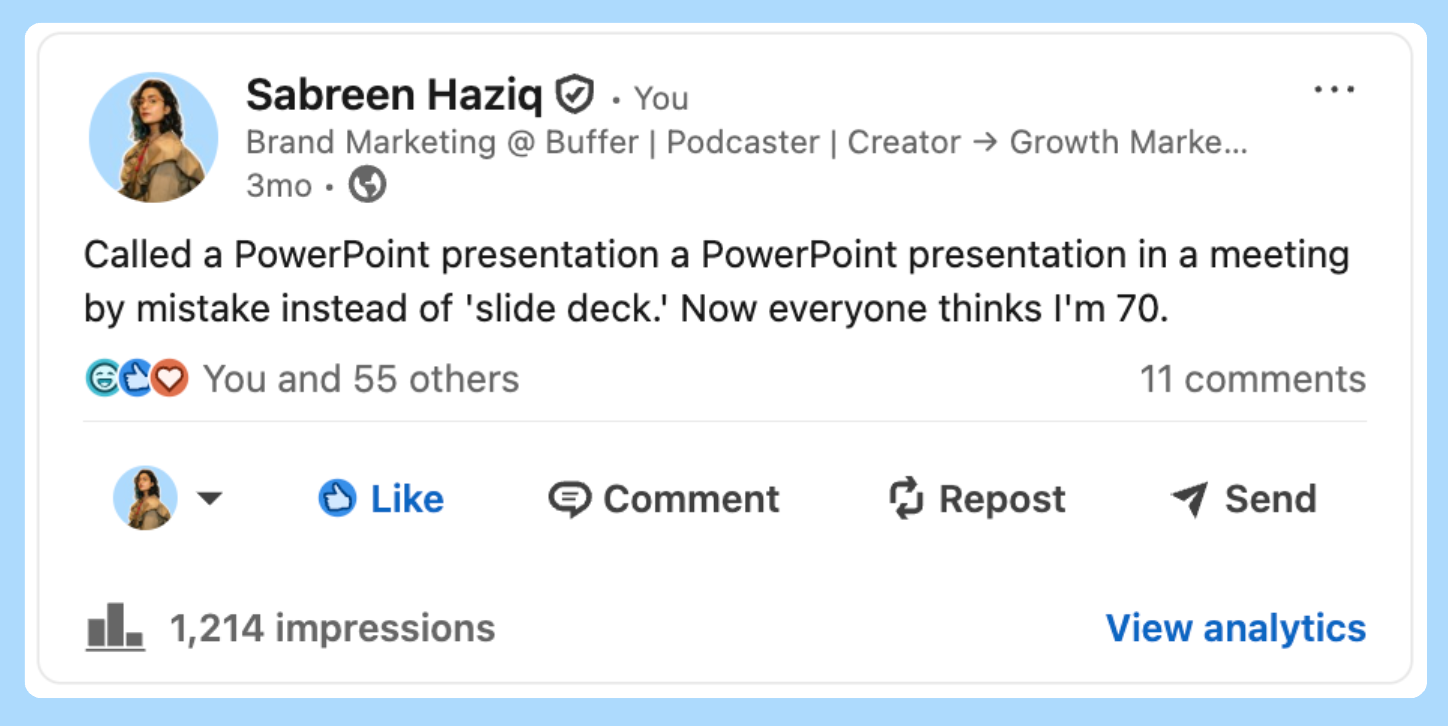
Not everything needs to be a layered strategy breakdown or a personal transformation. Sometimes, value looks like a moment of levity — a well-timed meme, a cheeky reflection on remote work, or a post that makes someone laugh between back-to-back meetings.
That kind of content brings ease back into the process. It resets your creative energy and gives your audience a reason to engage with you in a more human way.
This pillar became my pacing mechanism. A buffer (no pun intended) that kept me consistent without running on empty.
A big unlock in my consistency journey was realizing I didn’t have to come up with every idea on my own.
Some of the richest content I’ve created has come directly from conversations with my community — questions in the comments, DMs from peers, reactions to a post that struck a chord. The proof of what resonates is right there, if you’re paying attention.
So I leaned in with thoughtful call-to-actions (CTAs), and gave my LinkedIn community something to lean on and engage with.
I began asking direct questions, planting intentional call-to-actions (CTAs), and inviting my community to shape the direction of my content. That did two things:
- It showed my audience I cared about their perspective.
- It helped me crowdsource the gaps — the follow-ups, the “wait, but how?” moments — that I wouldn’t have spotted alone.
And bonus: it boosted my engagement. More comments meant more reach, which added fuel to my consistency engine.
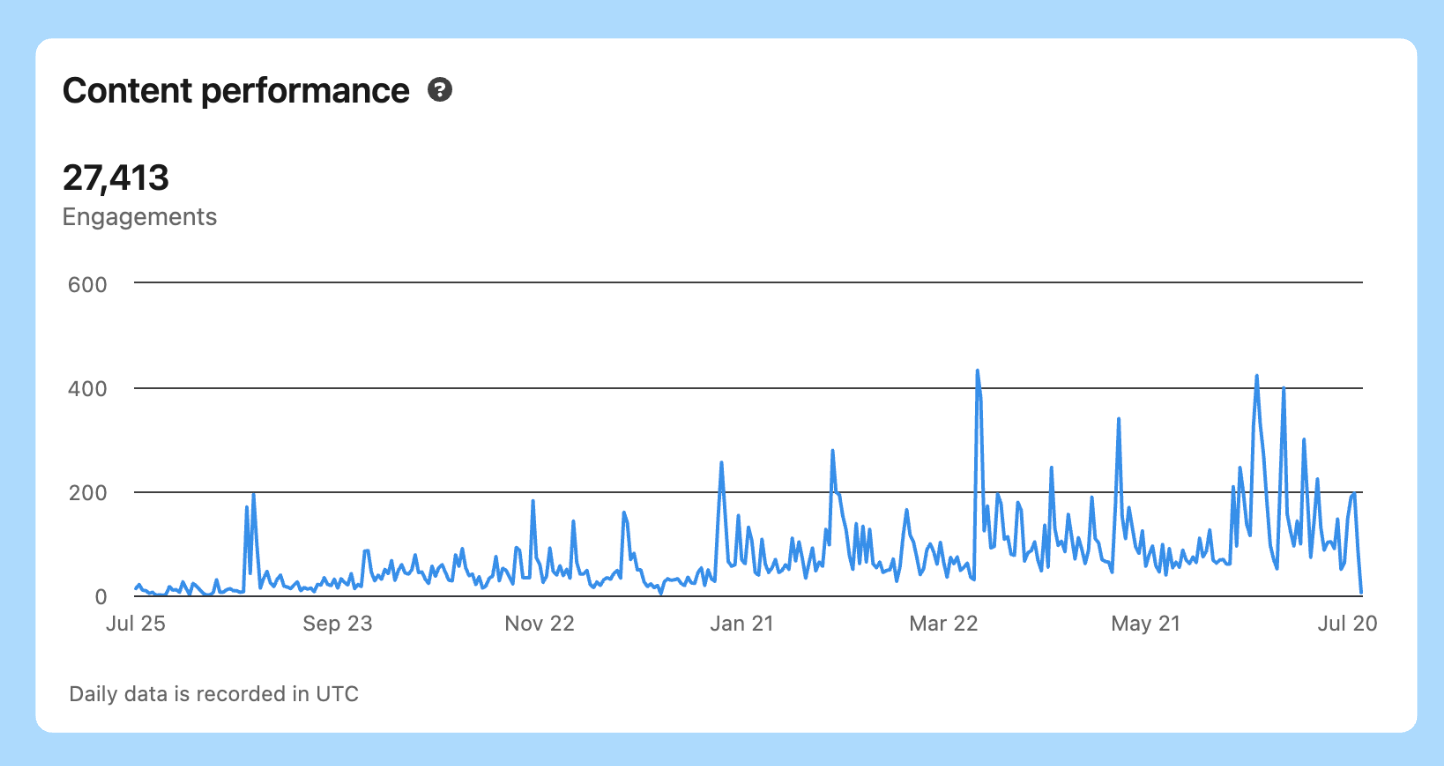
Here’s one example: I shared a post about what helped me get hired at Buffer, and ended it with a simple CTA — What else would you like to know? That one question sparked a rich conversation and surfaced several new content ideas.
My teammate, Tamilore Oladipo, shared a similar experiment on the Buffer blog: she turned a single community exchange into a week’s worth of posts.
That’s the power of staying close to your audience.
Bringing your community in doesn’t just help you generate content, it gives you a chance to land and expand: to reinforce your existing pillars and branch into new, relevant clusters as they emerge.
I treated everything around me like content
One of the biggest mindset shifts I made was this: content isn’t just something you sit down to create, it’s something you notice.
I started treating the world around me as a running bank of creative prompts. Every object, every memory, every tiny moment held potential if I paid close enough attention.
Take the marble coaster on my desk, for example. At first glance, it’s just decor. But look closer and it holds the very first podcast artwork I ever designed — for The Lavender Fix, my self-improvement podcast. That coaster could easily anchor a post about how I began my podcasting journey, how I came up with the name, or why I made specific design choices as a first-time creator using Canva. It’s a story starter.
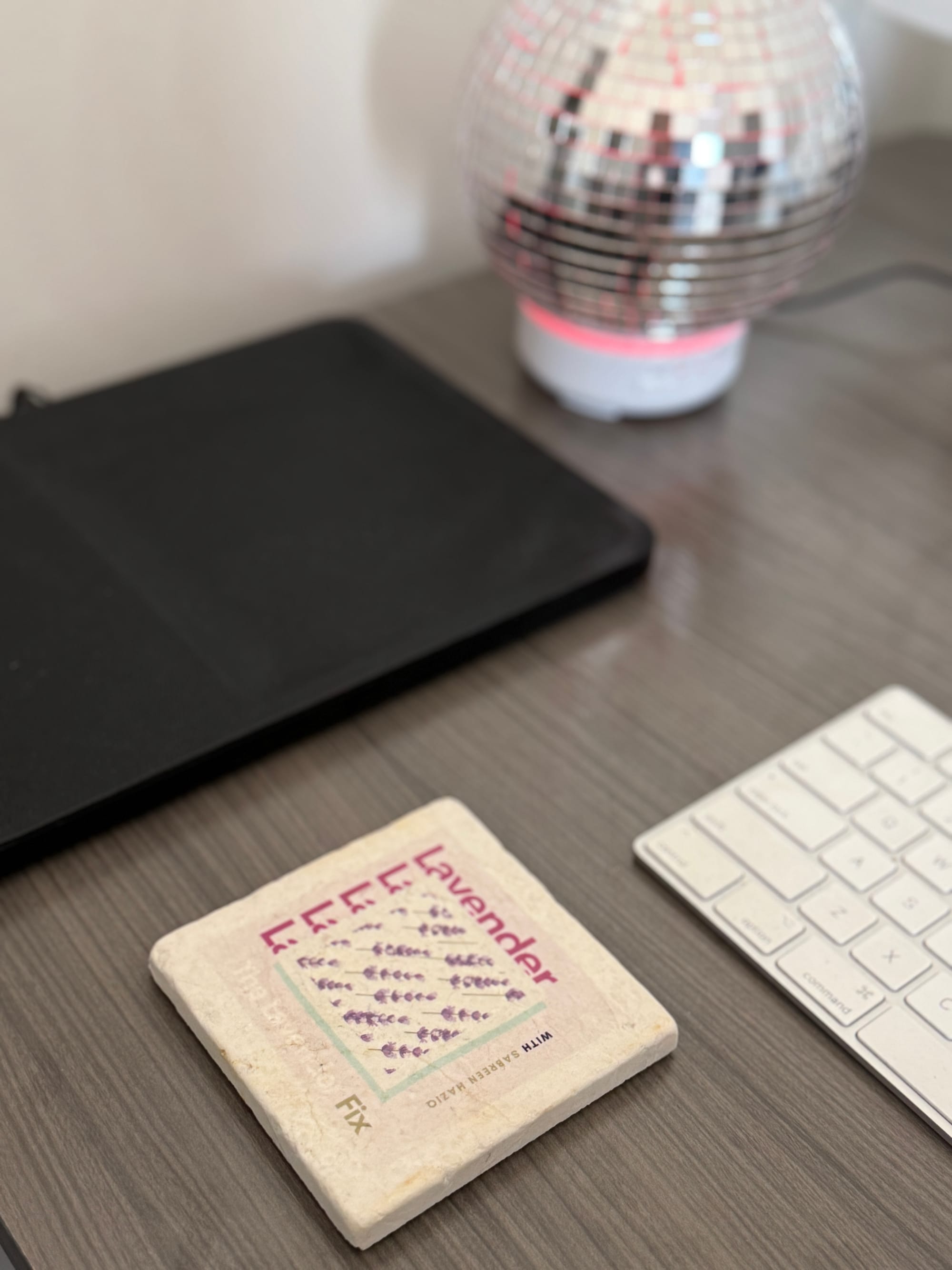
Once I adopted this lens, everything became a bridge — a way to connect the present with past experiments or future ideas. That shift made me more observant, and it sharpened my storytelling instincts.
It also nudged me into more visual thinking. I found myself reaching for my phone more often to capture a photo that could complement a post. Over time, my content evolved from purely text-based to more layered, visual storytelling — without ever feeling forced.
I challenged myself to notice more, and with that, my posts became more visual. Gradually, I began layering photos into my text-first content, adding a creative dimension to my workflow I hadn’t anticipated.
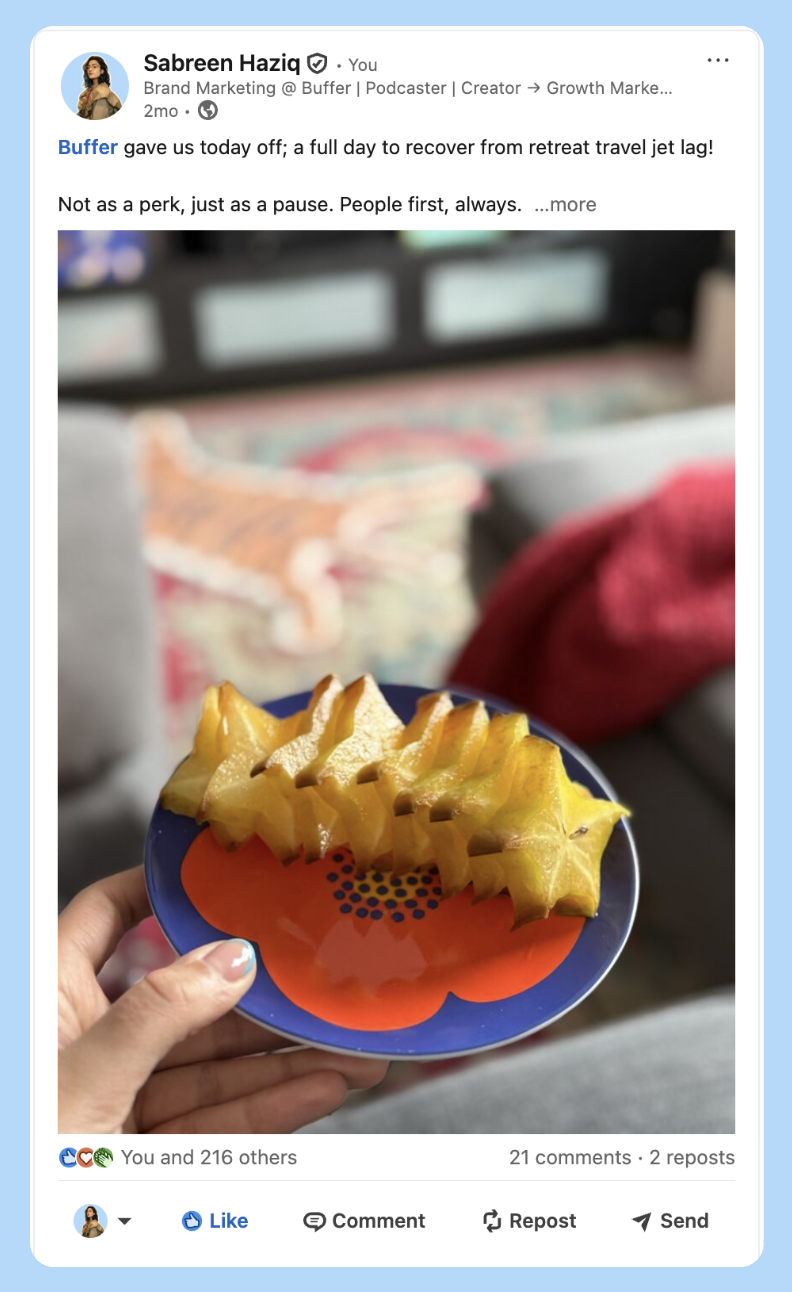
I carved out time to reflect intentionally
I let the content stew simmer, and went for a walk. Not literally. Please don’t leave a pot on the stove and head out the door!
But metaphorically, I did that every day. My daily walks helped me create space for the ideas to arrive.
I made it a habit to walk 10,000 steps each morning — no distractions, just me and my thoughts. Those walks became a ritual for reflection. I’d process top priorities, sketch out campaign ideas, mentally write newsletter intros, and so much more.
With a clear mind and no agenda, ideas surfaced more freely. I’d jot down quick thoughts in my notes app, and by the time I got home, I’d often have the makings of 5–10 posts. This very blog outline? Walk-born!
Personally, this approach created space for my bigger ideas to incubate. It gave me time to process any emerging thoughts, and return to them with clarity. This is what Tiago Forte refers to as building a “Hemingway bridge” in his book, Building a Second Brain: ending your creative sessions (in my case, a walk) in a way that makes it easier to resume later. Instead of starting from scratch each time, you pick up right where you left off, with clarity and context intact.
So, let the stew simmer, go for a walk, and let your thoughts breathe. Then, get back to the kitchen.
I leaned into performance data
Remember when I said I’m a creative marketer with a growth marketing wired brain? This is where that came into play!
I’ve always looked for ways to connect story to signal, and data became the coach behind my consistency. And with Buffer’s LinkedIn personal profile analytics (which, by the way, we just launched this month!), I developed a clear sense of how my posts were performing week-over-week.
And here’s the thing about numbers: they tell you what your gut can’t.
Some of my most high-performing posts were the simplest — low-lift, low-effort thoughts that sparked way more conversation than my more nuanced pieces. That’s the beauty of data. It challenges your assumptions and gives you the confidence to keep going.
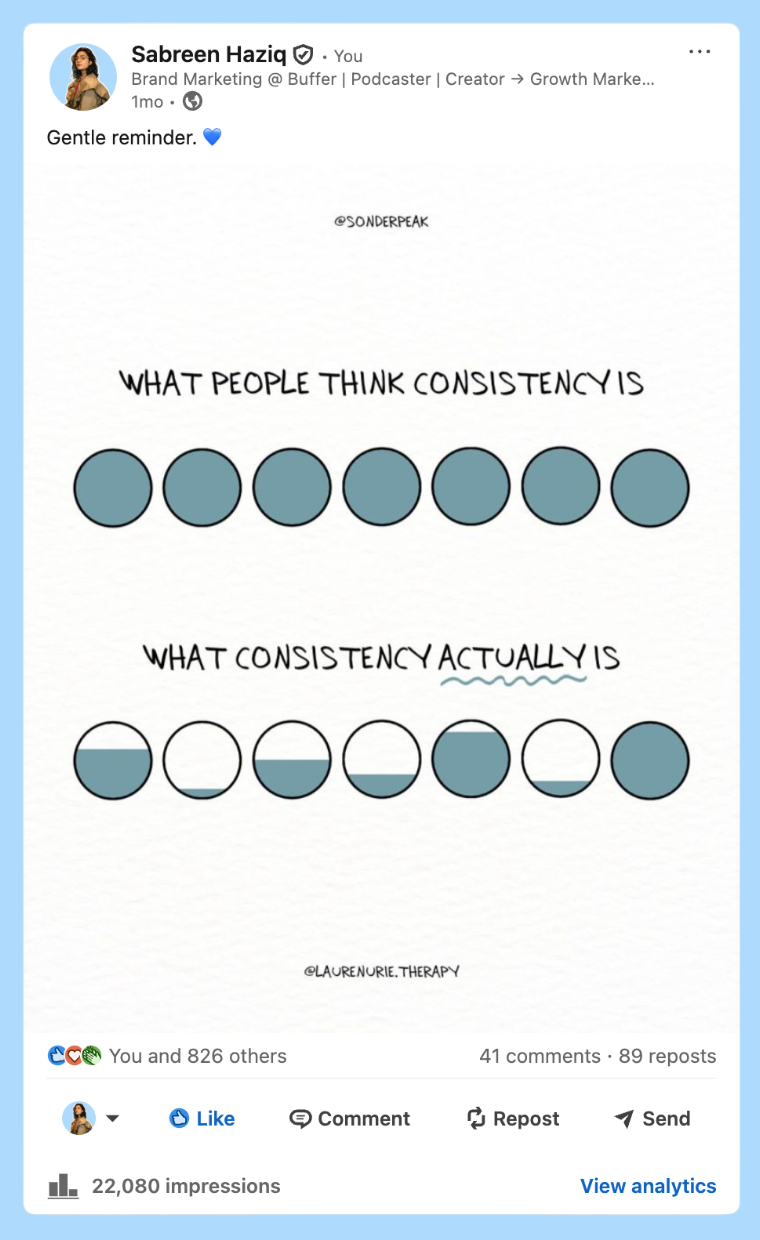
You can’t plan virality, but you can plan mentality around what gets you there.
By tracking the right signals, I was able to build on what worked, shape my strategy, and compound my momentum over time.
Finally, bringing it all together
In the end, it wasn’t one big moment that changed everything; it was the compounded impact of small, consistent actions.
Now, 356 days into that consistency streak, here’s where I’ve landed:
- 1,214,768 impressions
- 313,550 members reached
- 27,430 engagements
- 684.2% audience growth
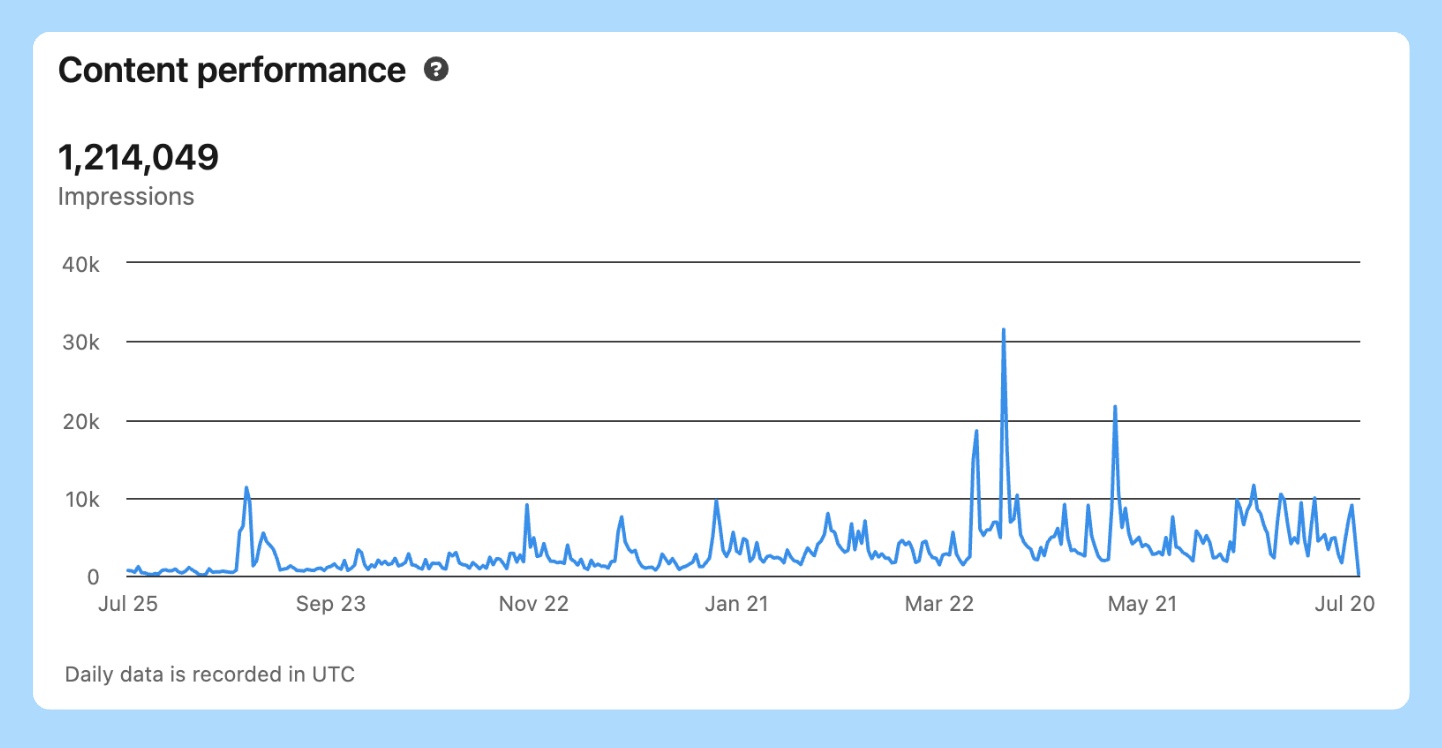
A lot has changed, and I’ve learned more than I expected.
While I still consider myself an aspiring LinkedIn creator, this past year has taught me a lot. Joining Buffer gave me the space — and the support — to lean into content more intentionally. Plus, being surrounded by a team of internal creators at Buffer means I’m never short on inspiration, encouragement, or a reminder that we’re all figuring it out as we go.
I’m always looking to grow, experiment, and learn from others.
My next milestone on LinkedIn? 20K!
If you’re on a similar path, or just starting out, I’d love to hear from you! You can find me on LinkedIn or on my website.

